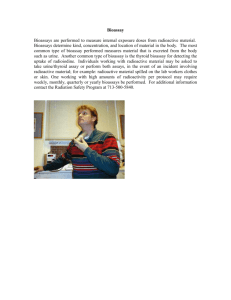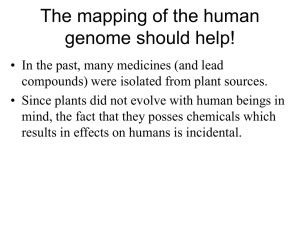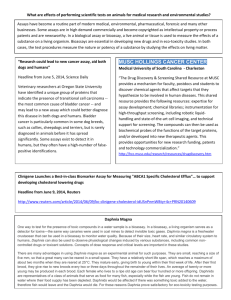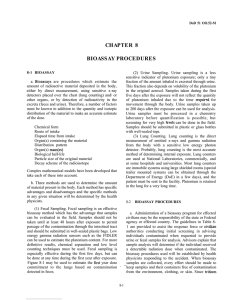RI-12 - Colorado State University
advertisement
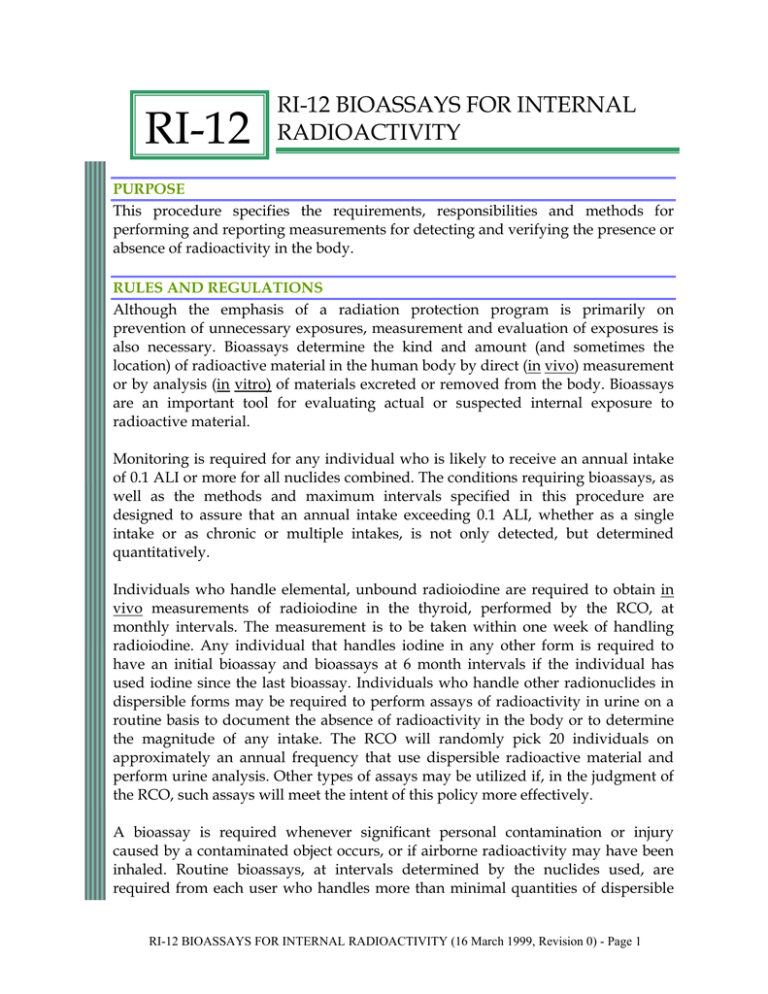
RI-12 RI-12 BIOASSAYS FOR INTERNAL RADIOACTIVITY PURPOSE This procedure specifies the requirements, responsibilities and methods for performing and reporting measurements for detecting and verifying the presence or absence of radioactivity in the body. RULES AND REGULATIONS Although the emphasis of a radiation protection program is primarily on prevention of unnecessary exposures, measurement and evaluation of exposures is also necessary. Bioassays determine the kind and amount (and sometimes the location) of radioactive material in the human body by direct (in vivo) measurement or by analysis (in vitro) of materials excreted or removed from the body. Bioassays are an important tool for evaluating actual or suspected internal exposure to radioactive material. Monitoring is required for any individual who is likely to receive an annual intake of 0.1 ALI or more for all nuclides combined. The conditions requiring bioassays, as well as the methods and maximum intervals specified in this procedure are designed to assure that an annual intake exceeding 0.1 ALI, whether as a single intake or as chronic or multiple intakes, is not only detected, but determined quantitatively. Individuals who handle elemental, unbound radioiodine are required to obtain in vivo measurements of radioiodine in the thyroid, performed by the RCO, at monthly intervals. The measurement is to be taken within one week of handling radioiodine. Any individual that handles iodine in any other form is required to have an initial bioassay and bioassays at 6 month intervals if the individual has used iodine since the last bioassay. Individuals who handle other radionuclides in dispersible forms may be required to perform assays of radioactivity in urine on a routine basis to document the absence of radioactivity in the body or to determine the magnitude of any intake. The RCO will randomly pick 20 individuals on approximately an annual frequency that use dispersible radioactive material and perform urine analysis. Other types of assays may be utilized if, in the judgment of the RCO, such assays will meet the intent of this policy more effectively. A bioassay is required whenever significant personal contamination or injury caused by a contaminated object occurs, or if airborne radioactivity may have been inhaled. Routine bioassays, at intervals determined by the nuclides used, are required from each user who handles more than minimal quantities of dispersible RI-12 BIOASSAYS FOR INTERNAL RADIOACTIVITY (16 March 1999, Revision 0) - Page 1 radionuclides. A routine bioassay may be waived by the RCO when appropriate surveys for contamination, conducted according to recommended procedures during and after each use of radioactive material, demonstrate that there was essentially no exposure to dispersible radioactive materials. DEFINITIONS ALI: The annual limit of intake is the quantity of any radionuclide which, if taken into the body, produces an effective dose to internal organs that is equivalent in risk to the annual whole body dose limit of 5 rem. Because of differences in physiological transport mechanisms, the ALIs vary depending on the route of intake. For purposes of contamination control and bioassay procedures, the ALI for ingestion is used, since that is the most common route of accidental intake in research laboratories. Bioassay interval: The bioassay interval is the maximum time that may elapse between bioassays that will assure detection of the verification level for a given nuclide and assay method. The bioassay interval for a particular nuclide is determined by its physical and metabolic characteristics, and by the instrumentation used for the measurement. For most commonly used nuclides and typical analytical systems, the bioassay interval is 13 weeks (one calendar quarter); for 32P, and a few other very short-lived nuclides, however, the bioassay interval is only 4 weeks. Elapsed interval: The elapsed interval is the time since an assumed intake of radioactive materials or, if the time of intake is unknown, since the last bioassay. The elapsed interval is used to calculate the intake and the effective dose from a positive bioassay result. Intake & Uptake: The total quantity of radioactive material entering the body is referred to as the intake, whereas the quantity absorbed into organs, tissues or interstitial fluids is referred to as the uptake. Dispersible: In the context of bioassay requirements, "dispersible" refers to radioactive materials in any form that could be taken into the body and potentially transferred to body organs, tissues or fluids. Dosimetric assay: A dosimetric assay is performed by an accredited laboratory to provide data for annual dose determination. The need for a dosimetric assay will be determined by the RSO, but it is generally required for any individual whose cumulative annual intake is likely to exceed 0.1 ALI. RI-12 BIOASSAYS FOR INTERNAL RADIOACTIVITY (16 March 1999, Revision 0) - Page 2 Investigation level: An assay result that indicates a possible intake of 0.05 ALI or more will be investigated by the RSO to determine the cause of the exposure and corrective measures to prevent or reduce exposures in the future. Action Levels: A limit for removable surface contamination, specified in "ACTION LEVELS" (RI-10). CONDITIONS REQUIRING BIOASSAYS 1. A bioassay is required within 5 days for each individual having contamination of the skin or hair exceeding 10 action levels (see RI-10). 2. A bioassay is required within the normal bioassay interval for any individual having skin or hair contamination exceeding 1 action level (see RI-10). 3. A bioassay is required within 5 days for each individual involved in a spill, or other uncontrolled release, of >10 ALI of radioactive material outside of a properly functioning fume hood or >100 ALI inside a hood. 4. A bioassay is required within 5 days for each individual who was present in an area during a time when removable contamination exceeding 100 action levels was present on any readily accessible surface (see RI-10). 5. A bioassay is required within the normal bioassay interval for each individual who was present in an area during a time when removable contamination exceeding 10 action levels was present on any readily accessible surface (see RI10). The optimum time for performing a bioassay is within a few days after a potential exposure. Each user should have a bioassay performed within a few days after handling any unusually large quantities, or after performing any procedure involving a greater than usual opportunity for intake. Subsequent routine bioassays would not be required again until the end of another full bioassay interval unless another unusual exposure situation occurs. The RCO will notify users when a routine bioassay is due, i.e. the expiration of the bioassay interval, but it is the responsibility of the user to have the bioassay completed promptly. Routine bioassays may be waived at the discretion of the RSO if the records of contamination surveys of both the user and the RCO verify that there was no exposure to unconfined radioactive materials exceeding the levels specified above and no incidents of personal contamination since the last bioassay. RI-12 BIOASSAYS FOR INTERNAL RADIOACTIVITY (16 March 1999, Revision 0) - Page 3 If no work with radioactive materials was performed since the last bioassay, or if survey records verify that there was no exposure to contamination exceeding the levels indicated below, this may be reported by checking the appropriate statement on the "BIOASSAY SCREENING" report form (RF-12A). RADIOIODINE ASSAYS The preferred bioassay method for gamma emitting radioiodines is by in vivo measurement of the thyroid gland. These assays are performed by the RCO at prescheduled times. It is the responsibility of the user to obtain the thyroid assay whenever appropriate. Records of the results of these assays are maintained by the RCO, but are available to the monitored individual upon request. URINE ANALYSIS A urine analysis assay is one performed to determine if radioactivity is present in the body. For radionuclides other than iodines, routine bioassays are most easily performed by in vitro analyses of urine. The same instruments that are used to measure radioactivity in research samples may be used to detect the same radioisotopes in urine samples. Urine analysis assays are to be performed by the RCO for each individual randomly selected and reported on the "BIOASSAY SCREENING" form (RF-12A). For the nuclides used recently, determine the investigation level for the elapsed interval. For several commonly-used nuclides, the "BIOASSAY GUIDELINES" that follow, list the investigation levels for various elapsed times up to the maximum elapsed interval. For other nuclides, or other elapsed times, the investigation levels must be obtained from the RCO. The sample volume and minimum counting time must be selected so as to achieve a lower limit of detection (LLD) at least equal to the required investigation level. The "BIOASSAY GUIDELINES" provide examples for several common nuclides and liquid scintillation counting conditions, and may be used, if appropriate. The minimum counting time may be calculated as illustrated later in this procedure. For urinalysis by liquid scintillation counting, select a fluor that is suitable for large aqueous samples; Cherenkov counting may be used for 32P or other high-energy beta emitters. For urinalysis by gamma counting, as well as by liquid scintillation counting, proceed as follows: 1. To assure adequate sensitivity of the measurement, use the largest vial and sample volume that the counting system can accommodate. RI-12 BIOASSAYS FOR INTERNAL RADIOACTIVITY (16 March 1999, Revision 0) - Page 4 2. Each individual who supplies a urine sample is responsible for preparing their own sample for counting. The RCO will provide a liquid scintillation vial with the appropriate volume of flour and HCl. Form RF-12A will be provided with the vial and indicate the volume of urine to be added to the vial. 3. Each sample vial must be wiped down with a disinfectant (10% bleach) prior to the vial being handled by the individual actually counting the sample. 4. Prepare at least one identical tap water sample. Count the urine and the tap water samples for the same times. 5. Record the sample data and results on the "BIOASSAY SCREENING" form (RF12A). Calculate the activity concentration (dpm/mL) in the urine sample, using the measured efficiency calculated from the urine standard(s) for the nuclide of greatest concern. 6. Compare the assay result with the investigation level for the nuclide(s) of interest, based on the elapsed interval since the last use (or last bioassay). If the assay result is less than the investigation level, sign the form and file in the urine analysis binder and include a copy in the individual’s personal file. If the assay result exceeds the investigation level, inform the RSO immediately. 7. Once the urine sample has been counted, the sample may be poured down the drain. If blood is visible in the urine, the sample must be disinfected prior to sink disposal. Personnel handling urine samples must wear a buttoned laboratory coat, closed-toe shoes, full coverage of legs and latex gloves. If there is a likelihood that the urine samples may splash (such as during sink disposal), then goggles and a face mask must be worn. If a sample spills, immediately cover the spill with absorbent material such as paper towels, pour disinfectant on the towels, wait 30 minutes then dispose of the material. Skin or mucous membrane contact with urine containing visible blood must be reported to the Biosafety Officer within 24 hours of the exposure. RI-12 BIOASSAYS FOR INTERNAL RADIOACTIVITY (16 March 1999, Revision 0) - Page 5 MINIMUM COUNTING TIME CALCULATION The lower limit of detection (LLD) for which the risks of false negative results and of false positive results are each 5% is defined as follows: LLD = 4.66(SDb)/Eff where: LLD = disintegrations in sample in time T = VL x Vol x T 4.66 = the product of the distribution parameters needed to establish the 5% error limits SDb = standard deviation of the background (tap water) count = Nb0.5 = (RbxT)0.5 Nb = total background counts in time T Rb = background count rate, in cpm Eff = detection efficiency, in counts/dis (a nominal efficiency may be used for screening assays, whereas it should be determined experimentally for verification assays) VL = verification level for elapsed interval since last bioassay, in dpm/mL Vol = volume of urine in sample, in mL T = minimum counting time required, in minutes = Rb(4.66/VL x Vol x Eff)2 RI-12 BIOASSAYS FOR INTERNAL RADIOACTIVITY (16 March 1999, Revision 0) - Page 6 BIOASSAY GUIDELINES URINALYSIS CRITERIA FOR SELECTED RADIONUCLIDES1 Nuclide H 3 Elapsed Interval (weeks) 1 4 8 13 Investigation3,2 Level (dpm/mL) 22,200 5,160 740 65 Minimum Count Time (minutes)4 1 1 1 1 14 C 1-3 4-7 8-10 11-13 >30 25 20 12 N/A 90 70 90 32 P 1 2 3 maximum: 4 400 160 90 48 4 6 10 20 35 S 1 4 8 13 1,600 660 200 48 1 1 1 5 THYROID MONITORING CRITERIA FOR RADIOIODINES Elapsed Interval (weeks) 1 2 4 8 13 1. 2. 3. 125 I Action Levels (nCi in thyroid) Investigation2 120 110 90 60 30 131 I Action Levels (nCi in thyroid) Investigation2 40 20 6 0.5 0.2 For nuclides that are not listed, contact the RCO for appropriate criteria. Investigation levels are based on a single intake of 5% of the ALI at the beginning of the elapsed interval or on specific requirements outlined in the license(s) issued to Colorado State University. Minimum counting times are based on a sample volume of 1 mL counted with a typical liquid scintillation counter. RI-12 BIOASSAYS FOR INTERNAL RADIOACTIVITY (16 March 1999, Revision 0) - Page 7 RF-12A BIOASSAY SCREENING (Please type or print legibly) Last Name: First Name: CSU ID: Principal User: Signature: Your Social Security Number will be used ONLY for identification purposes to track radiation dosimetry, training and other records maintained by the Radiation Control Office. The records are confidential and may not be viewed by anyone except for yourself and the RCO staff. Providing your Social Security Number is done so on a completely voluntary basis. If you do not wish to provide your Social Security Number for RCO purposes, you must obtain an alternate CSU Identification Number from Human Resources Services (x5796) or Admissions (x6909) in order to complete this form. Type of Bioassay: For RCO Use Only Thyroid Scan I have not used radioactive iodine since my last thyroid scan. Urine Analysis I have not used any type of dispersible radioactive material since my last urine analysis or whole body count. Whole Body Count If you checked either of the above exemption statements, sign and send this form to the RCO. I have not had the type of bioassay checked above. I have used dispersible radioactive material since my last bioassay. Complete the following table, sign and return this form to the RCO and call the RCO to set up a time for the bioassay. Radionuclides used since last bioassay (for thyroid scans provide information for iodine only) Action Levels Nuclide Approximately How Much Used? How Long Since Last Use? Investigation mCi weeks dpm/mL mCi weeks dpm/mL mCi weeks dpm/mL mCi weeks dpm/mL FOR RCO USE ONLY Assay Data: Sample Collection Date: Date Counted: Instrument Used (Make, Model, S.N.): Less than the investigation level? Signatures: Yes No Counted by: If above the investigation level, contact the RSO immediately. Verification of assay data: If this is a thyroid or whole body count, attach results, file in the corresponding detector binder and include a copy in the individuals personal file. If this a urine analysis, complete the following information, file in the urine analysis binder and include a copy in the individuals personal file. Prepare a urine sample and at least one tap water sample per 9 urine samples using the same volumes. Include 0.01 ml of concentrated HCl per ml of urine or tap water. If not counted for the minimum time required for the critical nuclide and the elapsed time, the assay will not be valid. Volume of samples: Total counts from samples – Urine: Counting efficiency for the assay: mL Fluor: mL Count time: minutes Water: counts/dis Concentration in dpm/ml: (Urine sample counts) – (Water sample counts) (sample volume (mL)) x (Count time (min)) x (Efficiency (counts/dis)) = dpm/mL RI-12 BIOASSAYS FOR INTERNAL RADIOACTIVITY (16 March 1999, Revision 0) - Page 8 nCi nCi nCi nCi
